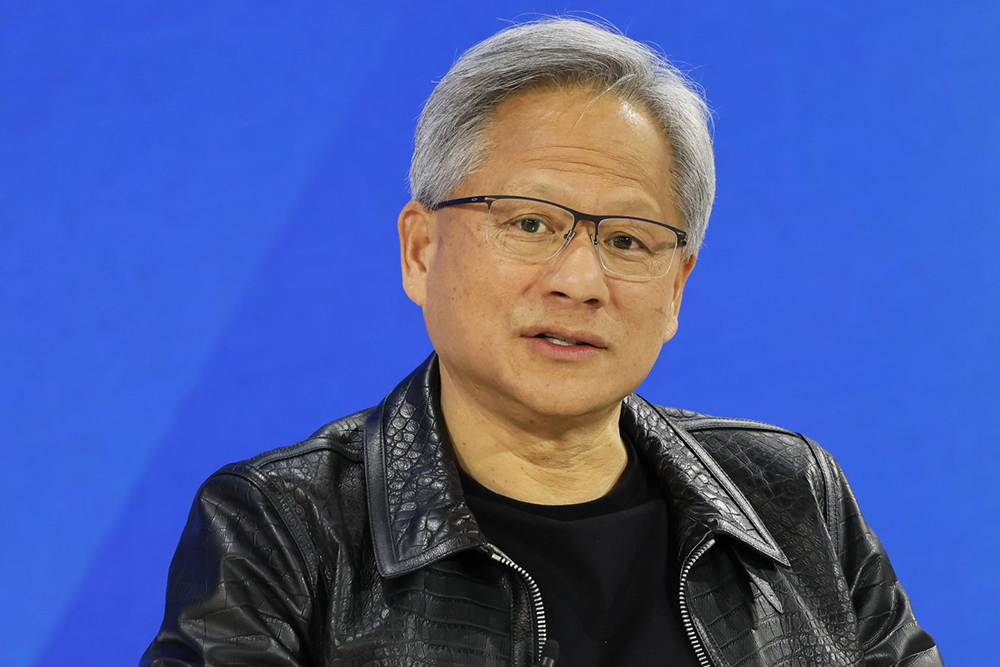
英伟达老板黄仁勋最近感觉自己压力山大,因为全球的AI芯片压力都压在了他的肩膀上。
英伟达已经是一家市值达2.9万亿美元的半导体巨头了。作为英伟达的创始人和CEO,黄仁勋在上周三接受采访时谈到了他当前面临的压力,特别是能够运行最新AI系统(比如GPT-4以后的最新大模型)的芯片供给严重不足的问题。
现在,英伟达的所有客户都在虎视眈眈地盯着他们——他们每从英伟达拿到一枚AI芯片,对他们来说都是一种竞争优势,因为他们的对手就少拿到了一枚。而黄仁勋的工作就是走好这根“钢丝”,尽可能平衡供给分配,以免危及客户关系。
他在高盛举办的一次科技会议上表示:“不管是我们的组件,还是我们的技术、基础设施和软件,在交付的时候,大家都是很情绪化的,因为这直接影响到了他们的收入,直接影响到了他们的竞争力。”
至于黄仁勋说的“情绪化”究竟是怎么一种情绪,我们还不清楚。因为当我们提出采访请求时,英伟达拒绝就此事发表进一步评论。但有一件事是肯定的,客户对英伟达的芯片存在大量需求,尤其是三个主要的超级云服务提供商——微软、谷歌和亚马逊。而且除了英伟达之外,目前也没有别人能满足他们的需求。英伟达已经控制了90%的AI芯片市场。
AI赛道上,速度就是一切
作为英伟达的创始人和CEO,黄仁勋会亲自对接重要客户。比如今年4月,他就向OpenAI的首席执行官山姆·阿尔特曼和总裁格雷格·布罗克曼亲手交付了全球第一台DGX服务器,该服务器搭载了升级版的Hopper系列AI训练芯片——也就是最新款的H200。
为了在AI赛道上阻击OpenAI,埃隆·马斯克近日透露,他计划在接下来的几个月采购5万片H200芯片,来让设在孟菲斯的xAI训练集群的算力增加一倍。目前,他的Grok-3 AI大模型正在那里接受训练。
马斯克近日在社交媒体上发帖称:“我们的根本竞争力取决于能否比其他任何AI公司更快,这也是唯一的追赶途径。如果我们的命运取决于能否做一家最快的公司,那我们就必须把自己的手放在方向盘上,而不是坐在后排瞎指挥。”
这也是为什么马斯克宁可冒着激怒特斯拉股东的风险,也要将英伟达的芯片分配给xAI,因为这些芯片本应被用于训练特斯拉的自动驾驶软件系统FSD。另外,xAI之所以能在短短三个月里上线全球 最大的单个计算集群,也与马斯克集中调用大量AI芯片不无关系。该计算集群由10万个英伟达H100 GPU芯片提供支持。
马斯克对于英伟达是个什么级别的客户,我们不得而知。但据英伟达透露,今年第二季度,仅四个数据中心客户,就贡献了它当季接近一半的营收。
黄仁勋在上周三的高盛会议上表示:“如果我们能满足每个人的需求,这种情绪就会消失,但这种情绪是很强的、很紧张的。我们肩上担负着很多责任,我们也会尽力做到最好。”
供应紧张将有所缓解
黄仁勋并不是在开玩笑。上个月底,英伟达公布了第二季度财报。Wedbush公司科技分析师丹·艾夫斯称其为“近年来最重要的科技公司财报”。
投资者和客户最关心的一个核心问题是,继Hopper之后的下一款人工智能芯片Blackwell能否按计划顺利推出,因为之前有报道表示Blackwell可能会跳票。但从财报上看,这个问题已经得到了解决。
在投资者电话会议上,黄仁勋证实,英伟达有必要对芯片的高精度光刻掩膜板的设计进行修改,以便提高每片硅晶上的芯片产量。同时他坚称,在今年第四财季结束前(也就是在明年1月底前),他仍然能够出货价值数十亿美元的Blackwell芯片。
与英特尔或德仪这种集成设备厂商不同的是,英伟达所有半导体生产都外包给了专门的公司,而且主要是台积电。台积电在芯片生产方面处于行业领先地位。
但是由于它的产能主要依赖台积电,这也意味着英伟达短期内无法迅速提高产能来回应需求的激增。更何况这些AI芯片的工艺极其复杂,需要长达数月的复杂工艺才能制造出来。
上个月月底,黄仁勋在接受彭博电视采访时表示,目前AI芯片供给紧张的情况正在得到缓解。
他在采访中表示:“我们预计第三季度的供应量将超过第二季度,第四季度的供应量将超过第三季度,明年第一季度的供应量又将超过第四季度。所以我认为,我们明年的供应状况将比今年有很大改善。”
如果这是真的,那么在不久的将来,黄仁勋终于可以少承受一些来自那些情绪激动的客户的压力了。(财富中文网)
译者:朴成奎
英伟达老板黄仁勋最近感觉自己压力山大,因为全球的AI芯片压力都压在了他的肩膀上。
英伟达已经是一家市值达2.9万亿美元的半导体巨头了。作为英伟达的创始人和CEO,黄仁勋在上周三接受采访时谈到了他当前面临的压力,特别是能够运行最新AI系统(比如GPT-4以后的最新大模型)的芯片供给严重不足的问题。
现在,英伟达的所有客户都在虎视眈眈地盯着他们——他们每从英伟达拿到一枚AI芯片,对他们来说都是一种竞争优势,因为他们的对手就少拿到了一枚。而黄仁勋的工作就是走好这根“钢丝”,尽可能平衡供给分配,以免危及客户关系。
他在高盛举办的一次科技会议上表示:“不管是我们的组件,还是我们的技术、基础设施和软件,在交付的时候,大家都是很情绪化的,因为这直接影响到了他们的收入,直接影响到了他们的竞争力。”
至于黄仁勋说的“情绪化”究竟是怎么一种情绪,我们还不清楚。因为当我们提出采访请求时,英伟达拒绝就此事发表进一步评论。但有一件事是肯定的,客户对英伟达的芯片存在大量需求,尤其是三个主要的超级云服务提供商——微软、谷歌和亚马逊。而且除了英伟达之外,目前也没有别人能满足他们的需求。英伟达已经控制了90%的AI芯片市场。
AI赛道上,速度就是一切
作为英伟达的创始人和CEO,黄仁勋会亲自对接重要客户。比如今年4月,他就向OpenAI的首席执行官山姆·阿尔特曼和总裁格雷格·布罗克曼亲手交付了全球第一台DGX服务器,该服务器搭载了升级版的Hopper系列AI训练芯片——也就是最新款的H200。
为了在AI赛道上阻击OpenAI,埃隆·马斯克近日透露,他计划在接下来的几个月采购5万片H200芯片,来让设在孟菲斯的xAI训练集群的算力增加一倍。目前,他的Grok-3 AI大模型正在那里接受训练。
马斯克近日在社交媒体上发帖称:“我们的根本竞争力取决于能否比其他任何AI公司更快,这也是唯一的追赶途径。如果我们的命运取决于能否做一家最快的公司,那我们就必须把自己的手放在方向盘上,而不是坐在后排瞎指挥。”
这也是为什么马斯克宁可冒着激怒特斯拉股东的风险,也要将英伟达的芯片分配给xAI,因为这些芯片本应被用于训练特斯拉的自动驾驶软件系统FSD。另外,xAI之所以能在短短三个月里上线全球 最大的单个计算集群,也与马斯克集中调用大量AI芯片不无关系。该计算集群由10万个英伟达H100 GPU芯片提供支持。
马斯克对于英伟达是个什么级别的客户,我们不得而知。但据英伟达透露,今年第二季度,仅四个数据中心客户,就贡献了它当季接近一半的营收。
黄仁勋在上周三的高盛会议上表示:“如果我们能满足每个人的需求,这种情绪就会消失,但这种情绪是很强的、很紧张的。我们肩上担负着很多责任,我们也会尽力做到最好。”
供应紧张将有所缓解
黄仁勋并不是在开玩笑。上个月底,英伟达公布了第二季度财报。Wedbush公司科技分析师丹·艾夫斯称其为“近年来最重要的科技公司财报”。
投资者和客户最关心的一个核心问题是,继Hopper之后的下一款人工智能芯片Blackwell能否按计划顺利推出,因为之前有报道表示Blackwell可能会跳票。但从财报上看,这个问题已经得到了解决。
在投资者电话会议上,黄仁勋证实,英伟达有必要对芯片的高精度光刻掩膜板的设计进行修改,以便提高每片硅晶上的芯片产量。同时他坚称,在今年第四财季结束前(也就是在明年1月底前),他仍然能够出货价值数十亿美元的Blackwell芯片。
与英特尔或德仪这种集成设备厂商不同的是,英伟达所有半导体生产都外包给了专门的公司,而且主要是台积电。台积电在芯片生产方面处于行业领先地位。
但是由于它的产能主要依赖台积电,这也意味着英伟达短期内无法迅速提高产能来回应需求的激增。更何况这些AI芯片的工艺极其复杂,需要长达数月的复杂工艺才能制造出来。
上个月月底,黄仁勋在接受彭博电视采访时表示,目前AI芯片供给紧张的情况正在得到缓解。
他在采访中表示:“我们预计第三季度的供应量将超过第二季度,第四季度的供应量将超过第三季度,明年第一季度的供应量又将超过第四季度。所以我认为,我们明年的供应状况将比今年有很大改善。”
如果这是真的,那么在不久的将来,黄仁勋终于可以少承受一些来自那些情绪激动的客户的压力了。(财富中文网)
译者:朴成奎
Nvidia boss Jensen Huang is starting to feel like Atlas with the weight of the world—or at least AI—bearing down squarely on his shoulders.
The CEO and founder of the $2.9 trillion semiconductor giant spoke openly on Wednesday about the tension he’s feeling, offering a glimpse into the pressure he faces to crank up the supply of microchips capable of training the latest AI systems like the successor to OpenAI’s GPT-4.
Customers see his products from the perspective of a player in a zero-sum game—each chip they receive means an advantage for them as well as a disadvantage for rivals who struck out. Huang’s job is to walk this tightrope, balancing the allocation of supply as best he can in order not to endanger client relationships.
“Delivery of our components—and our technology, and our infrastructure and software—is really emotional for people, because it directly affects their revenues, it directly affects their competitiveness,” he told a tech conference hosted by Wall Street investment bank Goldman Sachs.
What Huang exactly meant by “emotional” is unclear, and Nvidia declined to comment further when reached by Fortune. But one thing is certain: Customers—especially the three main cloud hyperscalers, Microsoft, Google, and Amazon, which each require a vast supply—realistically have nowhere else to turn. Nvidia controls 90% of the market.
Speed is everything in the AI race
As founder and CEO, Huang takes his responsibility to key customers personally. In April, he hand-delivered the world’s first DGX server equipped with its upgraded Hopper series AI training chip, the new H200, to OpenAI chief executive Sam Altman and president Greg Brockman.
And in his quest to topple OpenAI from the industry summit, Elon Musk recently revealed plans to purchase 50,000 H200s over the next few months to double the compute at his xAI training cluster in Memphis, where his rival AI model, Grok-3, is currently in training.
“Our fundamental competitiveness depends on being faster than any other AI company. This is the only way to catch up,” Musk explained in a recent social media post. “When our fate depends on being the fastest by far, we must have our own hands on the steering wheel, rather than be a backseat driver.”
That’s why he was willing to risk the ire of Tesla shareholders after allocating Nvidia chips to xAI that should have gone to training the carmaker’s self-driving software system, FSD. It also explains how xAI was able to bring online the largest single compute cluster in the world, powered by 100,000 Nvidia H100 graphic processing units, in the span of just three months.
Whether Musk is a preferred customer is not known, but Nvidia has revealed that just four data center clients were responsible for nearly half of its Q2 top line revenue.
“If we could fulfill everybody’s needs, then the emotion would go away, but it’s very emotional, it’s really tense,” Huang told the Goldman conference on Wednesday. “We’ve got a lot of responsibility on our shoulders and we try to do the best we can.”
Supply constraints set to ease going forward
Huang is not being facetious. At the end of last month, Nvidia posted fiscal second-quarter results that Wedbush tech analyst Dan Ives called nothing short of “the most important tech earnings in years.”
One of the core concerns that both investors and customers were most keen to hear addressed included any additional information on the rollout and ramp-up of Blackwell, the next series of AI chips after Hopper, following reports of delays.
During the investor call, Huang confirmed changes had to be made to the production design template, or “mask,” to improve the yield of chips printed on each silicon wafer. Nonetheless, he insisted he would still be able to ship several billions of dollars’ worth of Blackwell processors before the fiscal fourth quarter ends in late January.
Unlike integrated device manufacturers like Intel or Texas Instruments, Nvidia outsources all semiconductor fabrication to dedicated foundries that specialize in production technology, primarily TSMC. The Taiwanese giant leads the industry when it comes to efficiently miniaturizing transistors, the building blocks of the logic chips printed on each wafer.
That means, however, that Nvidia cannot quickly reply to demand spikes, especially since these chips go through months of complicated process steps before they are fully fabricated.
Pressed about the issue, Huang told Bloomberg Television late last month that constraints were easing.
“We’re expecting Q3 to have more supply than Q2, we’re expecting Q4 to have more supply than Q3, and we’re expecting Q1 to have more supply than Q4,” he said in the interview. “So I think our supply condition going into next year will be a large improvement over this last year.”
If true, then Huang can finally look forward to fewer tense moments with emotional customers in the not too distant future.






